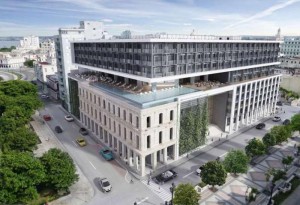 Almost 40 hotels, providing 18,000 new rooms to be inaugurated in the medium term, are currently under construction in Cuba, where authorities remain committed to the sustained growth of the tourism industry, as the driving force of the economy.
Almost 40 hotels, providing 18,000 new rooms to be inaugurated in the medium term, are currently under construction in Cuba, where authorities remain committed to the sustained growth of the tourism industry, as the driving force of the economy.
Forecasts for the present year were based on sector potential, and include the expected arrival of 5,100,000 international visitors, representing a 7.4% increase in comparison to 2018, as reiterated by Tourism Minister, Manuel Marrero.
There are already early signs that this figure will be reached, as Cuba welcomed one million international visitors five days before it did so in 2018, while January closed with an increase of 9% as compared to the same month of the previous year.
It is worth noting that the anticipated growth of this sector is not based solely on new investments, but also on plans for modernization and updating of the country’s existing hotel infrastructure. Meanwhile, diversification goes hand in hand with the development of event and incentive tourism, and the promotion of high-standard facilities in Havana.
The upcoming annual International Tourism Fair, FitCuba, to be held in Havana in May, will offer an opportunity to corroborate results in this regard, including the announced opening of a dozen new accommodations and the reincorporation of 1,121 refurbished rooms that were out of service.
Currently in different phases of construction are the Havana hotels: Prado y Malecón, Corona, Metropolitano, Gran Hotel, and those located on Malecón and D Street, 3rd and 70th Streets, and 25th and K Streets; while undergoing refurbishment are the hotels: Habana Riviera, Habana Libre, Deauville, Lincoln, Sevilla, Cohíba, Colina, Vedado, St. Johns, Neptuno Tritón and Copacabana. Reconstruction works are planned on another five, among them, the emblematic New York hotel.
Such a broad investment program includes extra-hotel services such as the Tarará and Hemingway marinas, and the Capdevila golf course; in addition to recreation and gastronomic centers, including the La Ferminia restaurant, and the Complejo 1830.
SAFE, QUALITY TOURISM
Sector authorities estimate that, for the first time, revenues in the current year will surpass 3 billion dollars, representing growth of 17%.
Greater service quality and diversity constitutes the cornerstone of efforts, supported by the intangible value provided by the security of the country, which leads to increased tourist arrivals, as visitors recognize and appreciate the safe conditions to undertake activities.
A series of international awards vouch for such conditions: Varadero features second place in the TripAdvisor 2019 Travelers’ Choice Awards for the world’s best beaches, after having placed third in 2018; while the hotels Paradisus Princesa del Mar, located at the same beach destination, and Havana’s Gran Hotel Manzana Kempinski and Hotel Nacional, were all recognized in different categories of the 2018 World Travel Awards, which identify excellence in all activities linked to the global travel and tourism industry.
Such honors, together with last year’s record number of international visitors, only serve to refute the U.S. State Department’s Cuba Travel Advisory, warning its citizens to reconsider travel to the island.
The advisory, in effect since November 2017, represents yet another orchestrated lie aimed at sabotaging Cuba’s economic and social development. Just like the ever-present blockade, it has had a negative impact, demonstrated by the 40% drop in U.S. visitors to the island following the issue of the warning, having seen previous growth of 175%.
However, people from other latitudes continue to come to Cuba, attracted by its climate, environment, culture, and safety. Meanwhile, several sectors in the U.S. itself have expressed their opposition to moves by the Donald Trump administration, including for example the U.S. Tour Operators Association (USTOA), which has insisted that Cuba is a “safe” destination.
Likewise, Cuba Educational Travel, a U.S. organization, reported that in an anonymous survey of citizens of that nation, 99.13% felt “safe” or “very safe” during their stay in the Caribbean country. The same opinion is shared by U.S. Senators who have traveled to the island, and refute the story of sonic attacks on diplomatic staff at their embassy in Havana, instead advocating the restoration of all operations of that mission.
Further arguments to support Cuba as a tourist destination include the Excelencias Award for Safest Travel Destination, received by Minister Manuel Marrero during the 38th International Tourism Trade Fair, FITUR 2018, held in Madrid; or the high level events and visits of dignitaries and personalities from around the world, who travel to Cuba to strengthen ties of friendship and collaboration.
In addition, the country’s potential is demonstrated by growing foreign investment in the sector. Two examples are the Meliá company, which continues to consolidate its presence in Cuba, operating 34 hotels with14,661 rooms; while the prestigious Asian chain MGM Muthu Hotels will open its fourth hotel in Cuba during the first half of this year. All this begs the question as to who losses out more from the U.S. obstacles to Cuban tourism.
(Granma)